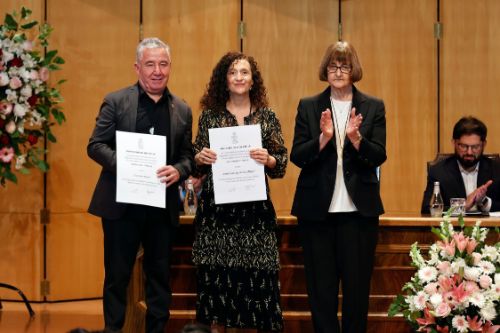A new collaborative study conducted by researchers from the Institute of Nutrition and Food Technology (INTA) and the Faculty of Science at the Universidad de Chile, in partnership with the Faculty of Medicine at the Universidad Diego Portales and the Center for Geroscience, Mental Health and Metabolism (GERO), proposes a novel perspective on brain aging.
In contrast to the traditional view that attributes it to progressive and inevitable cellular deterioration, this research supports the programmed longevity hypothesis, suggesting that aging is determined by a partial deactivation of a molecular program designed to maintain physiological youthfulness: the study proposes that exosomal microRNAs (miRNAs) released by hypothalamic neural stem cells (htNSCs) exert anti-aging effects by regulating the expression of key genes involved in maintaining brain function.
Through bioinformatic analyses integrating single-cell transcriptomic data of the brain and miRNA–gene interaction networks, the team identified a set of microRNAs secreted by hypothalamic neural stem cells that modulate pathways related to cellular senescence and stress. These small genetic regulators, present in the cerebrospinal fluid via exosomes, appear to maintain a youthful expression profile in cells such as oligodendrocytes and endothelial cells. The loss of these stem cells during aging, along with the decrease of their secreted miRNAs, activates gene networks associated with aging.
The study A Brain Anti-Senescence Transcriptional Program Triggered by Hypothalamic-Derived Exosomal microRNAs was published in the journal International Journal of Molecular Sciences (DOI: 10.3390/ijms25105467). This work offers new perspectives on a possible anti-senescence program regulated by the hypothalamus and highlights its relevance as a potential target for therapeutic strategies aimed at healthy aging and longevity.
Pamela Urrutia, academic at INTA Uchile —molecular biotechnology engineer and Ph.D. in Sciences with a mention in Molecular, Cellular and Neurosciences from the University of Chile— answers below some questions about the main findings and projections of the study.
– What evidence supports the idea of an active “longevity program” and its partial inactivation during aging?
Various studies support the existence of an active "longevity program" in young organisms, whose activity partially declines with age. This hypothesis is based on the observation of highly conserved molecular pathways across species —such as insulin/IGF-1, mTOR, AMPK, and sirtuins— which regulate essential functions like cellular repair, proteostasis, and stress response. During early life stages, these mechanisms operate efficiently; however, their activity gradually declines over time, favoring the accumulation of cellular damage and the loss of physiological function.
One of the most striking pieces of evidence comes from heterochronic parabiosis experiments, where two mice —one young and one aged— are surgically connected to share their circulatory systems. Notably, old mice receiving circulating factors from young partners show improvements in cognitive, muscular, and regenerative functions. This suggests that signals present in young blood can reactivate youth-associated programs.
These findings reinforce the idea that aging is not merely a passive process of wear and tear but also the result of the progressive deactivation of mechanisms that, under optimal conditions, promote health and longevity.
– How did you identify and validate the specific miRNA–target gene interactions mediating the anti-senescence effects in different brain cell types?
A previous study by Zhang and collaborators showed that, in middle-aged mice (16 months), there is a significant decline in the presence of 19 specific microRNAs in the cerebrospinal fluid. These microRNAs are released by neural stem cells located in the hypothalamus and could play a key role in protecting the brain from aging.
To understand how these microRNAs exert their anti-aging effects, it was first necessary to identify which genes they might be regulating. Since available information about these interactions in mice is still limited, we used human equivalents as a reference, as many of these relationships are conserved across mammalian species. For this, we used miRTarBase 9, a specialized database that compiles experimentally validated microRNA–target gene interactions.
We then analyzed whether these genes exhibited changes in activity in different cell types in the aging mouse brain. This analysis allowed us to establish a connection between the action of certain microRNAs and the activation of genetic programs that help maintain brain cell health during the aging process.
– Why are oligodendrocytes and endothelial cells especially sensitive to the loss of hypothalamic exosomal miRNAs with age?
We speculate that these cell types may be more sensitive for different reasons. Endothelial cells are part of the blood-brain barrier, a crucial structure that protects the brain from toxins and regulates substance exchange between the blood and the central nervous system. As they are in direct contact with circulating factors like miRNAs packaged in exosomes, it is logical to assume that they are among the most affected by the age-related decline of these molecules. The decrease in protective miRNAs with age may compromise their integrity, increase barrier permeability, promote inflammation, and alter brain homeostasis.
On the other hand, recent studies show that oligodendrocytes and their precursor cells exhibit the most significant changes among all brain cells during aging, suggesting largely unexplored plasticity. Oligodendrocytes are essential for producing myelin, the insulating sheath that wraps neuronal axons and enables efficient nerve impulse conduction. The loss of miRNAs that regulate key genes for their maturation and maintenance may directly affect their functionality, causing demyelination, reduced synaptic transmission speed, and progressive cognitive decline.
Together, these cellular dysfunctions progressively impair the brain environment and increase vulnerability to neurodegenerative diseases.
– What practical implications would restoring these miRNAs in humans have to prevent or reverse brain aging processes?
Restoring the microRNAs (miRNAs) that tend to decrease with age could open a new and promising therapeutic avenue to prevent —and even reverse— pathological aging. These small RNA fragments play key roles in regulating genes involved in processes such as inflammation, cellular stress, and neuronal survival, all of which are negatively affected over time.
From a practical standpoint, this raises the possibility of developing miRNA-based treatments that mimic the molecular profile of a young organism. One potential strategy would be the use of synthetic exosomes loaded with specific miRNAs, designed to travel through the body and act directly on the brain and other aging tissues, thereby reactivating genetic programs associated with cellular youth.
Such interventions could lead to cognitive improvements —such as memory and learning— as well as enhanced tissue regeneration capacity in older individuals.
Although more research is needed to validate these approaches in humans, targeted miRNA restoration represents an innovative frontier in regenerative medicine and a promising tool for promoting healthier and more functional aging.
Keywords: Aging; miRNAs; Bioinformatics; Exosomes; Transcriptomics; Neural stem cells





-3.png.png)
